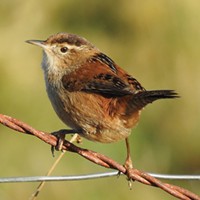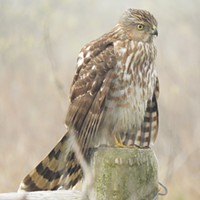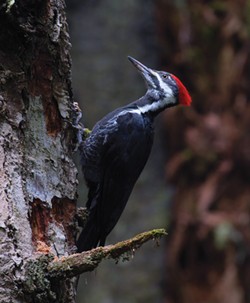[
{
"name": "Top Stories Video Pair",
"insertPoint": "7",
"component": "17087298",
"parentWrapperClass": "fdn-ads-inline-content-block",
"requiredCountToDisplay": "1"
}
]
Those of us who are besotted with birds can often trace our interest back to one particular bird, our "spark bird." Seeing that bird ignited a fascination with the species that's impacted our lives in myriad ways, from where we live to what we do for a living and how we spend our free time (birding, naturally).
While spark birds vary from person to person, they often have a few qualities in common: they're unexpected, beautiful to look at and create a vivid memory that never dims. Mine is the pileated woodpecker, a strikingly patterned Woody Woodpecker that's a pretty popular choice as spark birds go. Even though it was years ago, I remember the moment perfectly. I was a teenager driving a U.S. Forest Service truck when a pileated flew across the road in front of me and I was gobsmacked. There's more to the story, possibly involving a ditch and a tow truck, but I don't recall that part as clearly.
Sometimes a spark bird is a rarity but it doesn't have to be. When a common greenshank showed up in Humboldt County in 2001 — the first record of this exceedingly rare Asian shorebird in the lower 48 states — I dragged the whole family, newborn son and all, out to the Mad River to see it. And it was interesting enough. But it lacked that certain je ne sais quoi a spark bird needs, like color. And to not be a shorebird.
But the purple gallinule at the Arcata Marsh? It's the epitome of spark-birdness. The gallinule is a star, a rainbow-colored holiday confection of a bird that's thrilled hundreds of people, many of whom traveled a significant distance to see it. Heck, I'm adding it to my spark bird list right now. Who says we can't have more than one?
It was the day after Thanksgiving when the word went out about this astounding bird, and like a lot of other people I dropped what I was doing and went straight to the spot. As it happened, I was at a post-holiday leftover pie party, but everyone understood — even though I was, um, the host. This was a full-on five-alarm birding emergency.
But ever since the gallinule splashed down, I've been a bit worried about it. It's a stranger in a strange land, accustomed to bikini weather and the companionship of its colorful peers, not hailstorms, brittle frost-coated reeds and nothing but drab American coots and a hungry red-shouldered hawk to keep it company. I confess that when the temperatures drop into the 30s, I'm tempted to start knitting a tiny sweater. But for more than a month now, the bird has proved remarkably resilient, still present as of this writing.
The joy I feel when I see the purple wonderbird, which hasn't diminished over several sightings, is tempered by the sense that its presence is a sign of something seriously awry. It's a bird that simply shouldn't be here. And it's not alone. The Dec. 16 Arcata Christmas bird count noted 20 vagrant birds, including some eye-popping Mexican flycatchers like a vermillion and a dusky-capped one. They're a long way from home, too. And it's not just happening in Humboldt; vagrant birds appear to be on the increase all over the world. Last August the winds of Hurricane Idalia blew 150 American flamingos northward across 14 states, all the way to Wisconsin. Birders were delighted and, for a brief time, flamingos were more popular than cheese.
But the truths behind these unusual sightings are far less delightful. There's a lot of research on the causes of vagrancy, thought in part to be due to a bird's faulty internal navigation system. But I suspect when the data is sifted, human activity will be the primary cause, as it so often is. Climate change, with its severe weather patterns, wildfires and scorching temperatures, is an undeniable factor. Numerous bird species may be venturing out of their expected territories because life is unsustainable on their old turf.
Birds have long been indicators of how we're performing as stewards of this beautiful planet and our marks are not good. The National Audubon Society reports that the number of birds in the U.S. has declined by 3 billion over the last 50 years, and that a devastating two-thirds of our North American bird species face extinction in the near future.
On some level, I always knew birds were in trouble, even as a young birder growing up in New Hampshire. I knew when the hundreds of warblers that used to make a migration stop in the spruce trees behind our house, covering the branches like brilliant living Christmas ornaments, began to thin out and disappear. I knew when the marsh down the road where I'd done my early birding and seen so many "firsts" — first green heron, first hooded merganser, first wood duck — was deemed by the city to be the perfect site for a new airport runway. The next time I visited it, I cried when I found the wood duck nesting boxes I'd built bulldozed into the ground along with the trees.
But some things have changed for the better since then. Wetlands are recognized for their value and importance in sustaining a wide diversity of life forms, and they have some legal protections. Here in Humboldt, the Arcata Marsh is an example of something gone right. We're incredibly fortunate that years ago, when the city knocked around a few ideas regarding what to do with the former mill site perched on Humboldt Bay, a handful of visionaries decided to create a multi-use sanctuary that provides an important migratory rest stop for thousands of birds.
So when an exotic visitor like a purple gallinule lands in our midst, it's more than a checkmark on our life list. It's a wake-up call. Our planet is changing. And birds are telling us we need to change, too. All of us can be visionaries. And the tremendous surge in the popularity of birdwatching as a hobby has created a diverse, energized group of citizen scientists that's a force to be reckoned with.
Let's designate the purple gallinule as our official Humboldt spark bird. And let's make 2024 the year we use that spark to do good. It doesn't take a grand gesture. We could start by googling "How to help birds" for some simple and practical suggestions. Even small steps will lead us in the right direction.
Welcome to 2024. May it be the very best year for you, for our planet and for birds.
Sarah Hobart (she/her) is a freelance writer based in Humboldt County.
Speaking of...
-

A Chime of Wrens
Apr 11, 2024 -

Bird Names for Everyone
Feb 29, 2024 -

Censored Stories, AI Moguls and Visiting Birds
Dec 8, 2023 - More »
more from the author
-
A Chime of Wrens
- Apr 11, 2024
-
Bird Names for Everyone
- Feb 29, 2024
-
Birding Facts and Myths
- Dec 7, 2023
- More »
Latest in Get Out
Readers also liked…
-
A Walk Among the Spotted Owls
- Apr 27, 2023

































